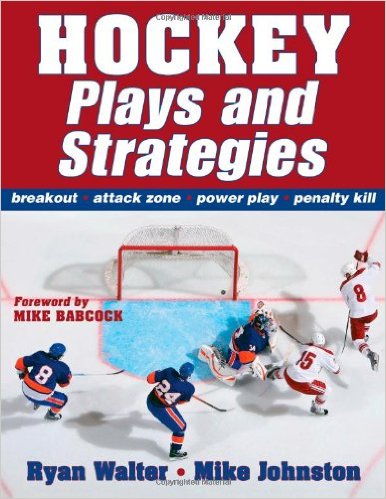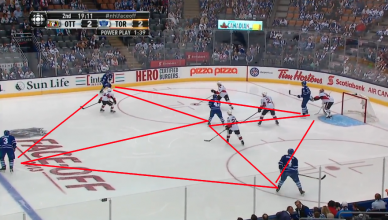DAY 2: POWER PLAY TALK
Special Teams, as expected, was a big focus in day 2 of Penguins training camp.
Both power play units setup in a 1-3-1 diamond for the most part, the type of power play the Penguins ran early last season but went away from more as the season progressed.
Group A saw a top unit of Beau Bennett (left half wall) – Patric Hornqvist (net-front) – Evgeni Malkin (right half wall) with Derrick Pouliot (Center Point) acting as the power play quarterback and Nick Bonino (slot) in the high slot as a passing/shooting option and support option.
Group B saw a top unit of Phil Kessel (left half wall) – Chris Kunitz (net-front) – Sidney Crosby (right half wall) with Kris Letang (center point) at the point and David Perron in the high slot.
Johnston in 2009 co-authored a book ‘Hockey Plays and Strategies‘ that had an extensive take on the 1-3-1 power play setup he believes in:
Excerpt from the book explaining the defined roles for each player in the 1-3-1.
Mid-Ice Point Man: An important strategy for this defenseman is to keep his feet on the blue line to allow more room to make a play or step into a shot. Slide along the line with deception while looking to find an open lane to the net. Quickly work the puck from left to right if the shot isn’t there, and then look to shoot again. Wrist shots to the net are also good, but it there is a chance for a slapshot, use it. In the 1-3-1 setup, the puck should revolve around this player.
Right and Left Side Half-Boards Players: Set up with the right shot on the left boards and the left shot on the right. These two players are definitely the quarterbacks. Both must be a threat to shoot or fake the shot and pass while also being calm under pressure. They should work the puck up to the high D as number one option, and don’t force plays through the box – often the play through the box will open up after recovering a rebound.
High Slot Player This can be a defenseman who slides in or a forward who plays defense and then moves into the slot area. Move into this position once the puck is under control. Depending on whether this player is a right or left shot, from one side he must be ready for a quick release shot and from the other side a shot pass. The shot pass is a play where the outside players shoot to the stick of the slot player for a redirect on the net. The slot player should move around in the space to distract the penalty killers. It is key that this player is ready to support both half-boards players when they are in trouble.
Net Man The net man, as the name indicates, plays the net area unless support is needed to settle the puck out. He may release to the strong side for a low pass and the potential to make a quick inside play. This is a good strategy, but the player has to read whether the high players are shooting or whether they need a low option. Stay active, and get into shooting lanes at the right time.
With the addition of Phil Kessel, the coaching staff is pondering the possibility of running two No. 1 units to start the season that would split up Sidney Crosby and Evgeni Malkin, though, that remains to be seen if it actually plays out. More on that a little later in the post as it plays into the desire to be able to run the type of 1-3-1 Johnston believes in.
SHOT THREAT FROM CENTER POINT
One priority for the staff is the Penguins power play units having a more consistent shot presence from the center point.
A major knock on the Penguins power play last season was the lack of a shot threat at the high point. Teams were able to constantly cheat over to Malkin and Crosby’s side.
The Penguins have to find a way to draw the opposition away from the likes of Crosby and Kessel and the coaching staff has identified that as the No. 1 issue that plagued the Penguins last season.
It’s a wait and see situation on who emerges as the top power play QB, key thing being a player who won’t force feed the Penguins stars and make the opposition have to decide — take away the shooting options at the half walls or the shooting option at the point —
Can’t defend all three shooting options.
Derrick Pouliot regarded by some as a potential great power play quarterback down the road, has to get away from being too tentative to shoot the puck to become the man for the job this season….. Sergei Gonchar doesn’t have a shot anymore and Kris Letang is often too erratic from the point…… Adam Clendening possesses an excellent low accurate hard shot but is unlikely to get a serious look with the top unit.
The best player last season at being a threat to shoot the puck and get it on net was Ian Cole late in the season, the season before was Matt Niskanen.
EASY TRANSITION FOR PHIL KESSEL WITH PENS POWER PLAY SETUP?
Phil Kessel’s sniping ability has some pundits predicting the Penguins to have their best power play since the Lemieux – Francis – Jagr – Nedved – Zubov unit in 1996 and be a unit that pushes 30%.
We’ll see about that but it’s not just Kessel’s shooting ability from the left side that Penguin coaches see as a likely big improvement for the Penguins creating more scoring chances on the man advantage.
After watching a lot of tape of the Leafs, they feel Kessel’s instinct to purposely [hide] shoot low for rebounds from the left side is another dimension the Penguins didn’t have in the past. The team feels a lot of second chance opportunities will be there for the likes of Hornqvist in front and Crosby or Malkin crashing from the right side.
Having a right handed sniper from the left side plays into Johnston’s desire to run a 1-3-1 diamond power play with the F4 in the slot which would be an easy transition for Kessel as it was the primary setup they ran in Toronto starting in 2013.
However, with Kessel now a trigger man from the left side, running the type of 1-3-1 that Johnston values won’t work with Sidney Crosby and Evgeni Malkin on the same unit as one individual put it because neither is going to play the high slot.
That’s what is at play here and because of that, Johnston and his staff are going to explore options of running two No. 1 units.
The problem is splitting high end talent up rarely works because it’s too difficult to make the minutes work.
It’s being pondered and likely even explored early in the regular season but unlikely to stick. [/hide]



Only if you don’t already have 15
Didn’t get 15.
2 power play teams would be ideal
How is keeping 1 of the 2 best players in the world on the benh when you have an advantage an ideal situation? Thinking that each unit can play 1:00 is completely unrealistic, 2 units means either Sid or Geno spends the majority of the pp on the bench which is never ideal in my mind.
Nhl 16 any good? Worth buying?
for sure…everything is back including EASHL.
Heard the revamped be a pro
Add me if you got ps4 psn walluk